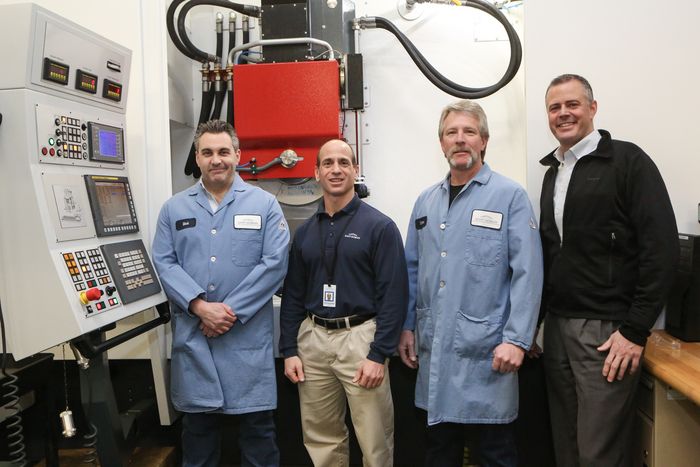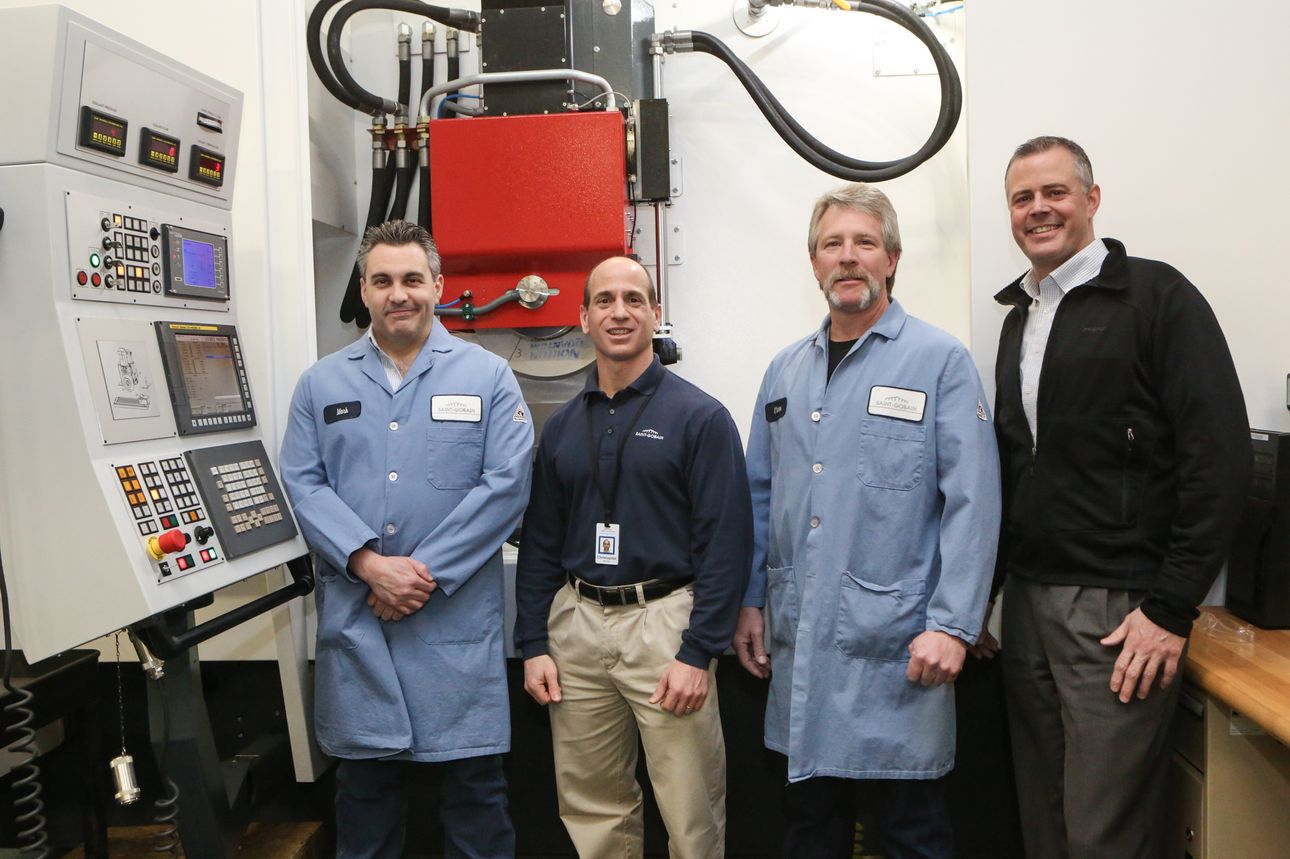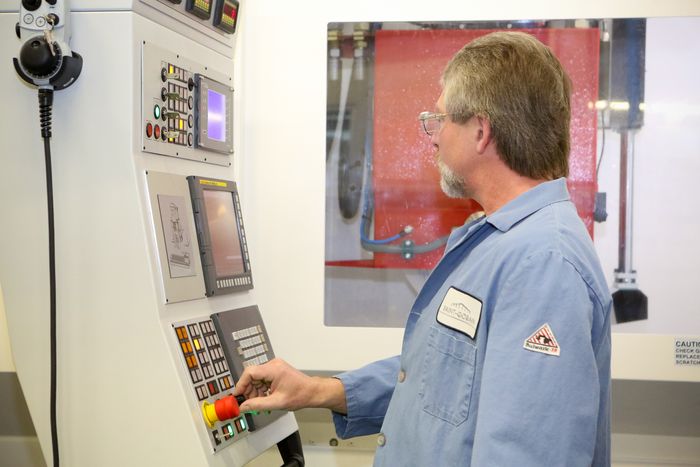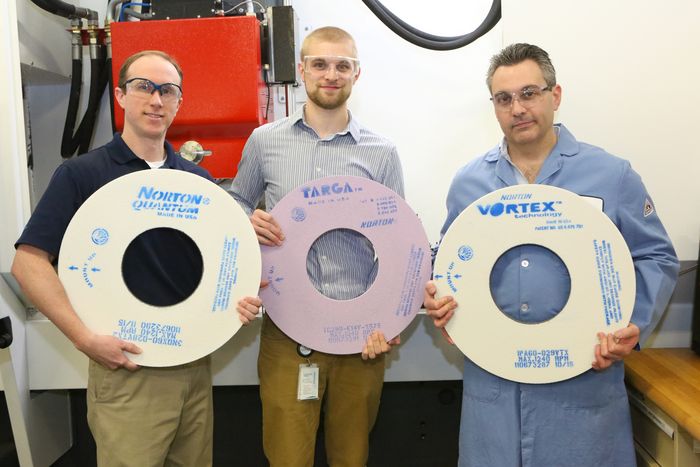Effective Customer Support Rides On the Best Grinding Technology
Norton, a brand of Saint-Gobain Abrasives, has teamed up with United Grinding to align a global material provider with the best grinding machines for R&D centers around the world. According to Saint-Gobain Abrasives Technical Marketing Director Worldwide Brian Rutkiewicz, “The core of Saint-Gobain Abrasives is product and application innovation. We depend on the high quality of United Grinding machines to help us deliver customer solutions through the best possible training and application support.”
Saint-Gobain Abrasives’ Higgins Grinding Technology Center in Northborough, Massachusetts, upgraded its BLOHM PROFIMAT 410 surface grinder to a MÄGERLE MFP 125 creepfeed grinding machine from United Grinding.
“The BLOHM gave us 30 years of faithful service during which we developed core competence in creepfeed grinding applications,” said Saint-Gobain Research Manager Chris Arcona. “This upgrade was a strategic decision between both parties to enable us to expand our capabilities in terms of customer application development, while continuing to support our general internal R&D activities.”
A grinding machine used in research and product development must provide wide application flexibility. It not only has to effectively run different wheel formulations with overhead, continuous or non-continuous dressing but also possess sufficient static and dynamic stiffness at a range of grinding power.
“It would be problematic if we tuned a new abrasive product to work well on a particular machine that, for instance, had a low dynamic stiffness,” explained Arcona. “Then, if that product ran on a machine with higher stiffness or a different dynamic response, it would perform very differently. So, a machine like the MÄGERLE MFP 125 is a must-have to meet and exceed customer expectations”
Saint-Gobain Abrasives also uses the MÄGERLE machine to introduce customers to new grinding products through its Precision Customer Training program, attended by more than 100 external users each year. “The program focuses on specific modules of grinding technologies. One of those modules is creepfeed grinding. And, our MÄGERLE showcases this application very well,” said Arcona.
Saint-Gobain Abrasives’ development efforts follow a systems approach that includes the four main inputs of the grinding process – machine tool, abrasives, grinding parameters and workpiece material type. According to Rutkiewicz, research efforts proceed through the elements of the system in steps. If a workpiece material changes, it is likely that grinding parameters will as well. Altering machine tool factors may be next, with a final step being changes in the elements of the grinding products that include abrasives, bonds and other variables. “When one of the key factors of the system changes, it causes us to change the inputs of the others,” he said.
Arcona added that the machine tool is a primary factor. “We believe that to develop the best abrasives, we need to understand how they will work with the best machine tool. Our partnership with United Grinding is a perfect exchange of knowledge – on the parameters side and on the machine tool side – to work with our customers’ materials and our abrasives.”
In the course of research, Saint-Gobain Abrasives doesn’t duplicate customer processes but instead simulates them using the information gathered to evaluate new product technologies. To quickly develop new abrasive products, the facility typically does not grind complex forms, per se. Instead, the end users’ key process parameters, such as chip thickness, stock removal rates, material type and coolant application, are analyzed. These, along with metrics of grinding system performance, such as form-holding capability and surface finish, can present a simple representation of an end user’s complex process.
In addition to the Higgins Grinding Technology Center, Saint-Gobain maintains a European Grinding Technology Center in Norderstedt, Germany, a Grinding Technology Center at Saint-Gobain Research India, and a China Grinding Technology Center in Shanghai. Around those large R&D centers and other local innovation centers, the company has established its abrasives application engineering centers of excellence for each region. Saint-Gobain Abrasives offers its customers a team of approximately 90 Application Engineers in all regions, with a technical expertise covering the full range of abrasive applications.
For instance, the company’s grinding research center in India recently moved into a new facility and has received delivery of a new BLOHM PROFIMAT MT 408 creepfeed grinder from United Grinding. According to Senior Research Engineer Shyam Komath, the India facility opted for that machine because it dovetails perfectly with the particular application needs of Indian manufacturing customers.
“As of now, we focus on new product development. Customers look to us and our technology to optimize grinding processes. That is the trend in India,” explained Komath. “Customers come into our R&D center and say, ‘Look, I have a problem; I would like to increase my productivity by 20 percent. Can you help me?”
Jaidev Krishnan, Application Engineer and OEM activities coordinator at Saint-Gobain Abrasives India, said, “The biggest advantage of having the in-house grinding machine from United Grinding is that customers are able to quantify data they may not have the time to do otherwise. And, they can quantify it by a variety of parameters, not just one or two.”
Operating different grinding machines at its various technology centers is a conscious strategy for Saint-Gobain Abrasives. The company sees the MÄGERLE grinder as an integral component to this strategy for large parts, such as land-based turbines and aerospace components, while the BLOHM machine is more appropriate for smaller jobs with blades and segments.
“We want our technology development systems to complement each other,” Rutkiewicz said. “We avoid duplicating the capabilities of our various global facilities.”
“Grinding of aerospace and power generation components currently represents a significant growth area for Saint-Gobain Abrasives, especially in light of the introduction of new materials, new turbine platforms from GE and Pratt & Whitney and increased production from Boeing and Airbus. The need for grinding turbine component applications continues to increase because the workpiece materials are becoming more difficult to machine conventionally.”
“Materials in use today have greater heat and abrasion resistance,” explained Arcona. “That means that tool wear in turning and milling these materials can be high, which can lead to inefficiencies in these machining processes. In these cases, material removal rates can be lower than those achieved with grinding, and grinding becomes a better solution than conventional machining.”
Rutkiewicz added that “Saint-Gobain Abrasives’ product development efforts are really about innovation through abrasive technology engineering and collaborative alliances. That’s why acquiring the MÄGERLE and BLOHM machines makes United Grinding more than a supplier but a valued partner.
“We see United Grinding as a leader in its industry. And, we want to deliver excellence to our customers with like-minded companies,” commented Rutkiewicz.
About Saint-Gobain
Backed by its experience and its capacity to continuously innovate, Saint-Gobain, the world leader in the habitat and construction market, designs, manufactures and distributes high-performance and building materials providing innovative solutions to the challenges of growth, energy efficiency and environmental protection. With 2015 global sales of $44 billion, Saint-Gobain operates in 64 countries and has more than 180,000 employees. For the fourth year in a row, the Company has been ranked by Thomson Reuters as one of the Top 100 Global Innovators. Saint-Gobain’s Abrasives business employs nearly 11,000 people at 64 manufacturing facilities in 27 countries.












